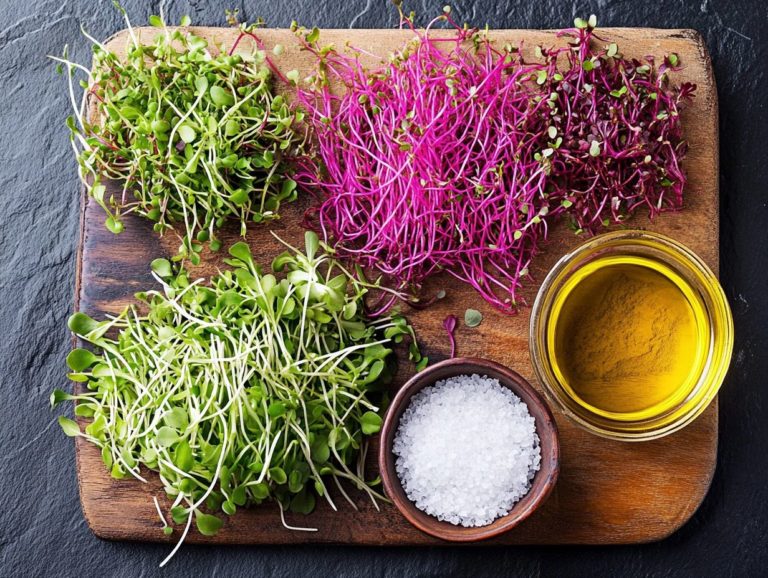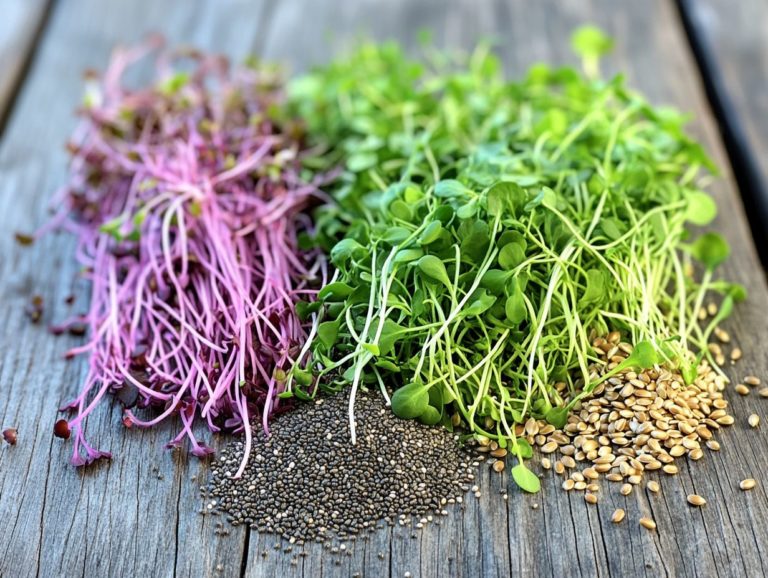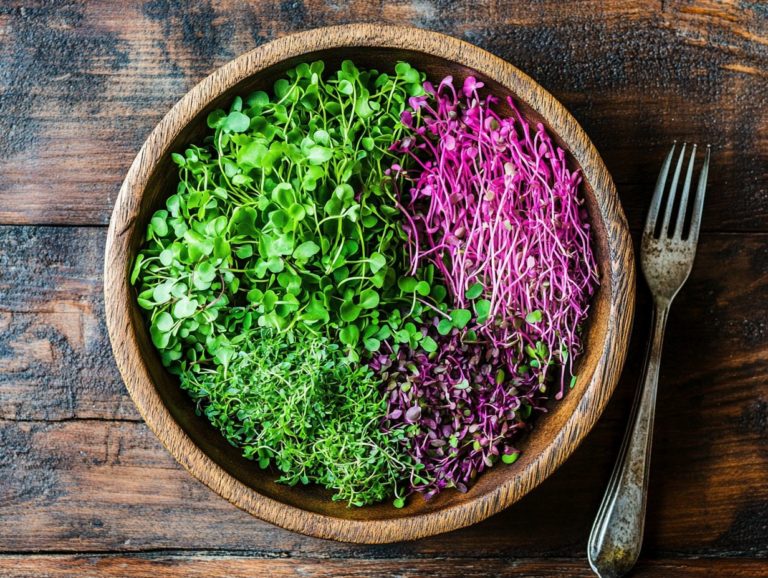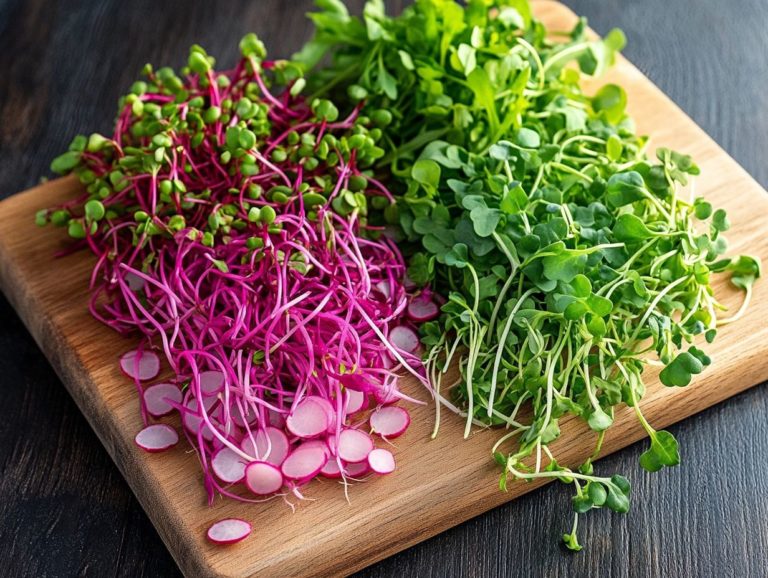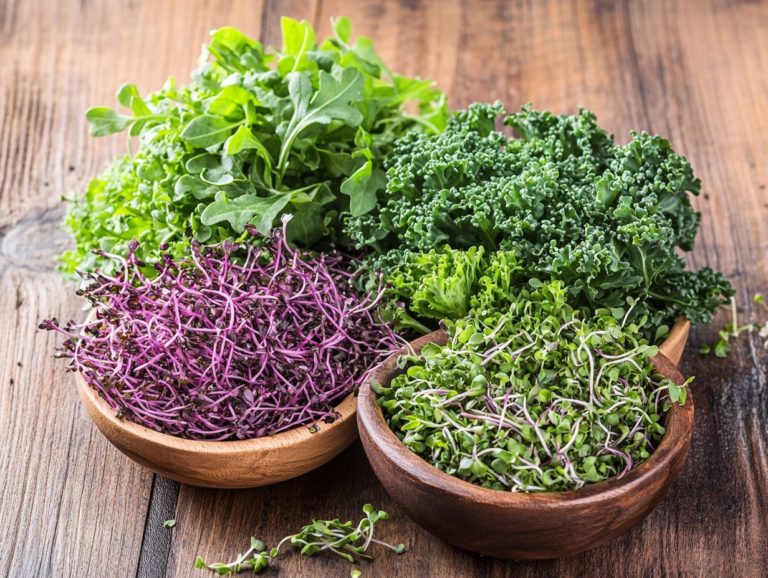Microgreens for a Healthier Lifestyle
Microgreens are small yet mighty plants, brimming with nutrients that enhance flavor and provide remarkable health benefits. These mini greens have captured attention with their vibrant colors and distinctive tastes, often boasting nutritional profiles that outshine their fully grown counterparts.
In this article, you will explore the world of microgreens. You will learn about their nutritional advantages and straightforward techniques to grow them right in your own home to improve health.
You will also uncover innovative ways to incorporate these greens into your meals and discover some of the finest varieties to cultivate. Get ready to transform your meals and boost your health with the amazing power of microgreens!
Contents
- Key Takeaways:
- What are Microgreens?
- Nutritional Benefits of Microgreens
- How to Grow Microgreens at Home
- Ways to Incorporate Microgreens into Your Diet
- Potential Health Effects of Microgreens
- Best Types of Microgreens to Grow
- Frequently Asked Questions
- What are microgreens and how do they contribute to a healthier lifestyle?
- What types of microgreens are best for a healthier lifestyle?
- What are the health benefits of incorporating microgreens into my diet?
- How can I use microgreens to make my meals healthier?
- Can anyone grow microgreens at home for a healthier lifestyle?
- Are there any potential risks to consuming microgreens?
Key Takeaways:
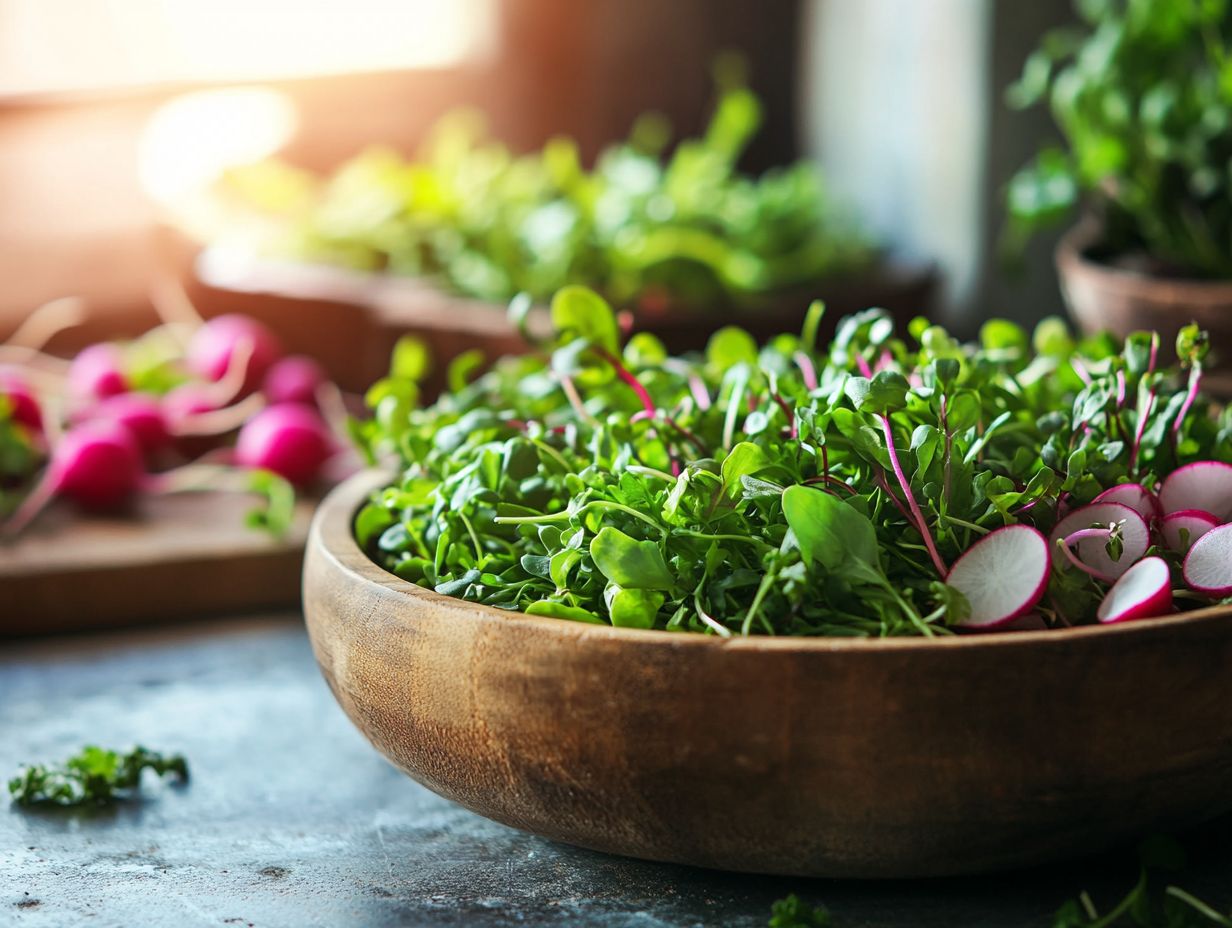
- Discover the world of microgreens – small, nutrient-packed versions of mature plants.
- Boost your health with microgreens’ high nutrient content, often surpassing their fully grown counterparts.
- Easily grow and incorporate microgreens into your diet for improved nutrition and potential health benefits.
What are Microgreens?
Microgreens are young vegetables harvested at an early growth stage, usually between 7 to 21 days after germination. These small, vibrant plants offer a remarkable burst of flavor and nutrients, making them a go-to choice for anyone focused on health.
From the Brassicaceae family think broccoli and radish microgreens to legumes like fenugreek and peas, they are cultivated for their concentrated nutrients and culinary flexibility. Microgreens elevate the visual appeal of your dishes and bring a treasure trove of plant-based substances that fit seamlessly into a healthy diet.
Definition and Types
Microgreens can be categorized by their diverse flavor profiles and impressive nutritional benefits.
Take arugula microgreens, for instance. Their vibrant, peppery taste wakes up your palate and packs a punch with vitamins A, C, and K, which can benefit your skin health and immune system.
Then there are sunflower microgreens with a nutty, earthy flavor that s rich in healthy fats and protein. These are perfect for muscle repair and boosting your energy levels.
If you’re leaning toward something a touch sweeter, basil microgreens deliver a fragrant aroma along with antioxidants that may help reduce inflammation. Each variety not only elevates your dishes with unique flavors but also serves as a powerhouse of essential nutrients. For more insights on how these varieties contribute to a plant-based diet, they make an invaluable addition to your balanced diet.
Nutritional Benefits of Microgreens
Microgreens are remarkable for their outstanding nutritional benefits, often boasting concentrated nutrients that outshine their mature counterparts in vitamins, minerals, and antioxidants. These tender young vegetables offer a wealth of essential nutrients like iron and natural compounds found in plants, making them a perfect enhancement to your balanced diet.
Their impressive fiber content supports digestion and plays a vital role in promoting overall health and wellness.
Comparing Nutrient Content to Mature Plants
When you compare the nutrient content of microgreens to that of mature plants, you’ll quickly notice that microgreens often boast concentrated nutrients, making them a superior choice for your health.
Research shows that microgreens, like broccoli, radish, and kale, can pack up to 40 times more vitamins and antioxidants than their fully grown counterparts. For example, a study published in the Journal of Agricultural and Food Chemistry revealed that certain varieties of microgreens are abundant in vitamins C and E, along with various phytonutrients that help fight oxidative stress in your body. To learn more about their advantages, check out the health benefits of microgreens explained.
These tiny greens aren t just nutrient powerhouses; they also offer notable health benefits, such as enhanced immune function and reduced inflammation. By incorporating microgreens into your diet, you can effortlessly boost your nutrient intake in a way that s both delicious and versatile.
Start your microgreens journey today and taste the difference!
How to Grow Microgreens at Home
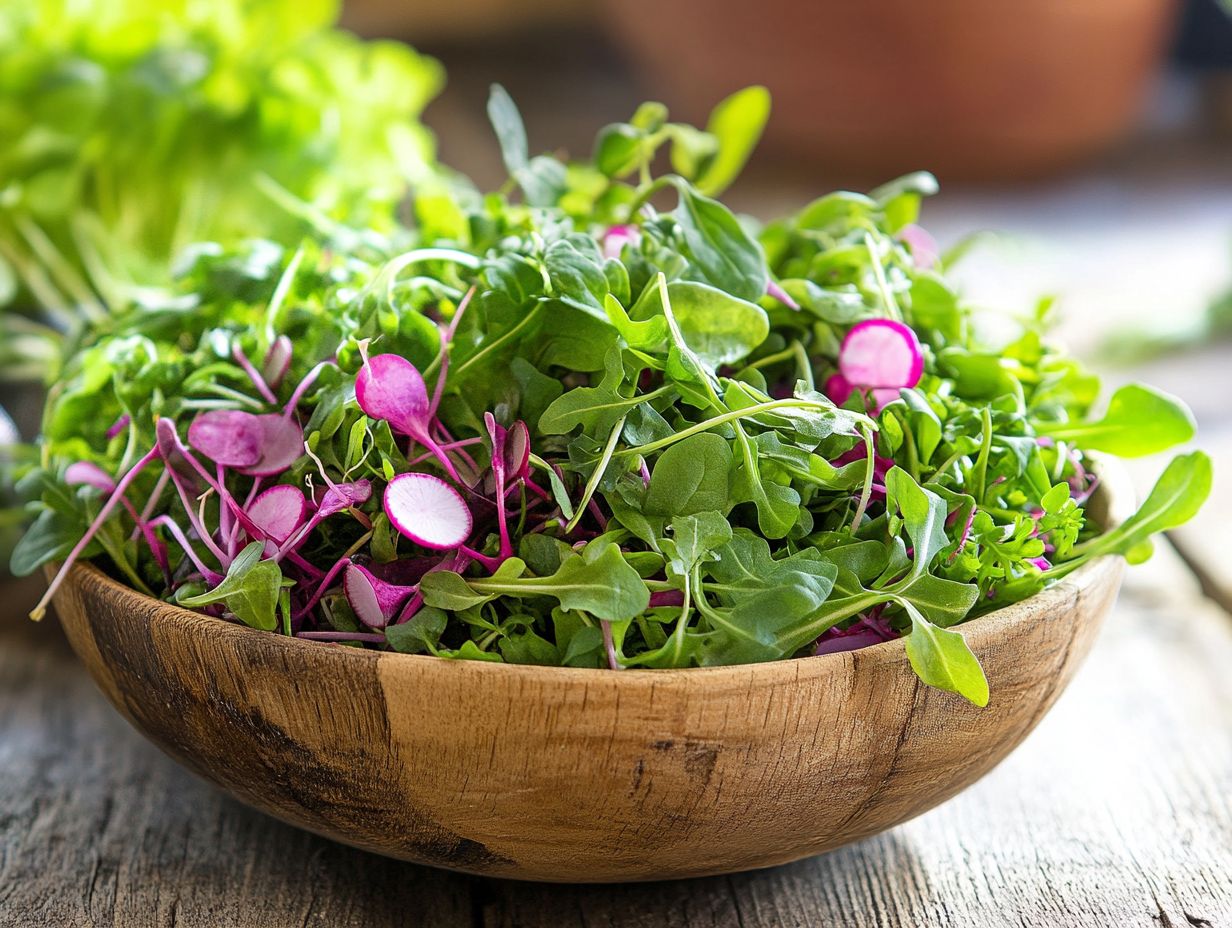
Growing microgreens at home is simple and rewarding. You can savor fresh, young vegetables packed with nutrients and enhanced flavors.
With just a little space and some basic equipment, you can grow these plants full of nutrients right in your kitchen or garden. Anyone passionate about health and wellness will love this easy and fun way to grow your own greens!
Step-by-Step Guide
This step-by-step guide offers a comprehensive approach to growing microgreens at home, ensuring you can cultivate the freshest vegetables effortlessly.
From selecting the right seeds to understanding the best lighting for growth, this guide covers everything you need to know. To start your microgreens journey, begin with soil preparation; using a quality seed starting mix enhances the growth of these vibrant greens.
Once you’ve prepared the soil, it’s crucial to sow the seeds evenly across the surface for the best coverage. A gentle watering promotes germination without disturbing the delicate seeds. When your microgreens reach the perfect height, harvest them carefully to add a burst of flavor and nutrients to your dishes.
Ways to Incorporate Microgreens into Your Diet
Incorporating microgreens into your diet can elevate both flavor and nutrition. It s a straightforward yet impactful way to enrich your meals with vitamins and antioxidants.
Whether you add them to salads or blend them into smoothies, these tiny powerhouses can transform any dish. They infuse meals with delightful crunch and vibrant color.
Recipe Ideas and Tips
Here are some delightful recipe ideas and tips for incorporating microgreens into your meals, allowing you to savor their unique flavors and enriching nutrients.
Microgreens have the power to turn ordinary dishes into culinary masterpieces. For instance, a sprinkle of radish microgreens can elevate a simple salad or sandwich with a peppery kick. Basil microgreens lend a fresh, aromatic touch to pasta dishes or pizzas.
Consider using sunflower microgreens for their nutty flavor in wraps or grain bowls, enhancing both taste and nutrition. When preparing soups, think about garnishing with dill or cilantro microgreens to brighten up the dish.
These tiny greens boost vitamins and minerals while adding visual allure, making your meals more delightful and healthful.
Potential Health Effects of Microgreens
Research is buzzing about the amazing health benefits microgreens can offer! These nutrient-packed plants may play a significant role in enhancing your health.
They can help lower cholesterol, regulate blood sugar levels, and even reduce cancer risks. As you explore natural methods to elevate your well-being, microgreens can be a powerful ally in your journey toward achieving these health goals.
Research and Evidence
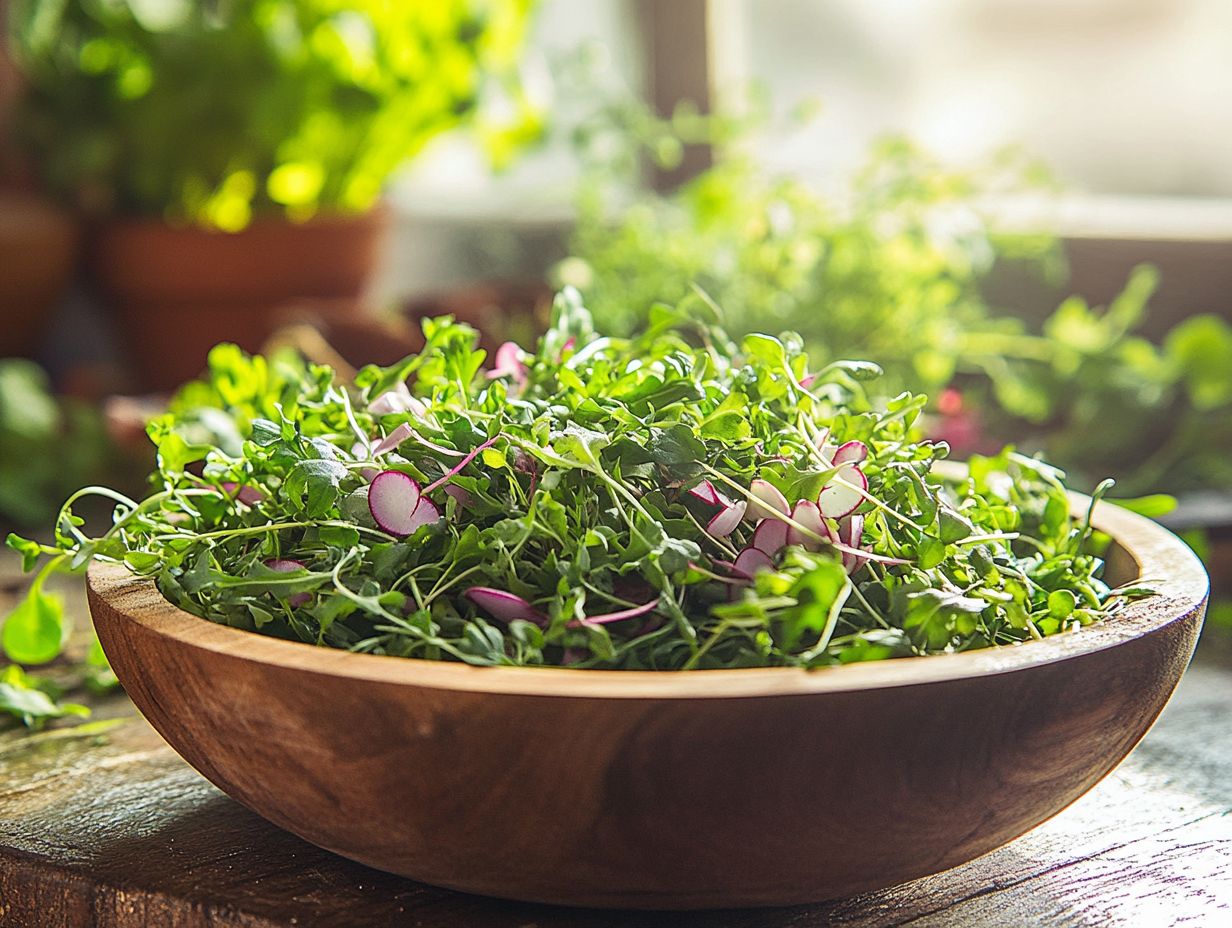
Research into the health effects of microgreens unveils a treasure trove of evidence that highlights their remarkable contributions to your overall health and wellness.
Numerous studies spotlight their exceptional nutrient density, often exceeding that of mature vegetables. These tiny greens, brimming with vitamins, minerals, and antioxidants, play a crucial role in boosting immune function and may help reduce inflammation. For those interested in growing them, check out the top microgreen varieties for health enthusiasts.
For example, specific varieties like arugula and radish microgreens have been associated with improved cardiovascular health and enhanced digestion. Many health experts recommend incorporating these best microgreens for nutritional value into your diet. Doing so not only elevates your nutrient intake but also fosters a healthier lifestyle overall.
Best Types of Microgreens to Grow
When you think about which microgreens to grow, it s vital to select the finest varieties that will not only thrive in your specific environment but also deliver significant nutritional advantages and delightful flavors.
Consider popular options like broccoli, radish, and spinach microgreens. They are favorite choices for home gardeners and chefs, bringing a range of tastes and being packed with essential nutrients.
Popular and Easy-to-Grow Varieties
Among the easy-to-grow varieties of microgreens, broccoli, radish, and spinach shine for their robust flavors and high nutrition.
Broccoli microgreens are particularly noteworthy, boasting rich compounds that can help reduce the risk of cancer. Radish microgreens add a spicy kick similar to their mature counterparts, making them a fantastic way to elevate your meals. Additionally, there are many unique microgreens to elevate your dishes, like spinach microgreens, which are celebrated not just for flavor but also for impressive levels of vitamins A, C, and K.
All these varieties thrive in well-drained soil with plenty of sunlight, making them perfect candidates for your home garden. By adding these lively microgreens to your meals, you can unlock a wealth of health benefits, including improved digestion and enhanced immunity.
Frequently Asked Questions
What are microgreens and how do they contribute to a healthier lifestyle?
Microgreens are young vegetable greens harvested when they are only a few inches tall. They’re bursting with nutrients and add a burst of flavor to dishes, making them an excellent addition to a healthy diet.
What types of microgreens are best for a healthier lifestyle?
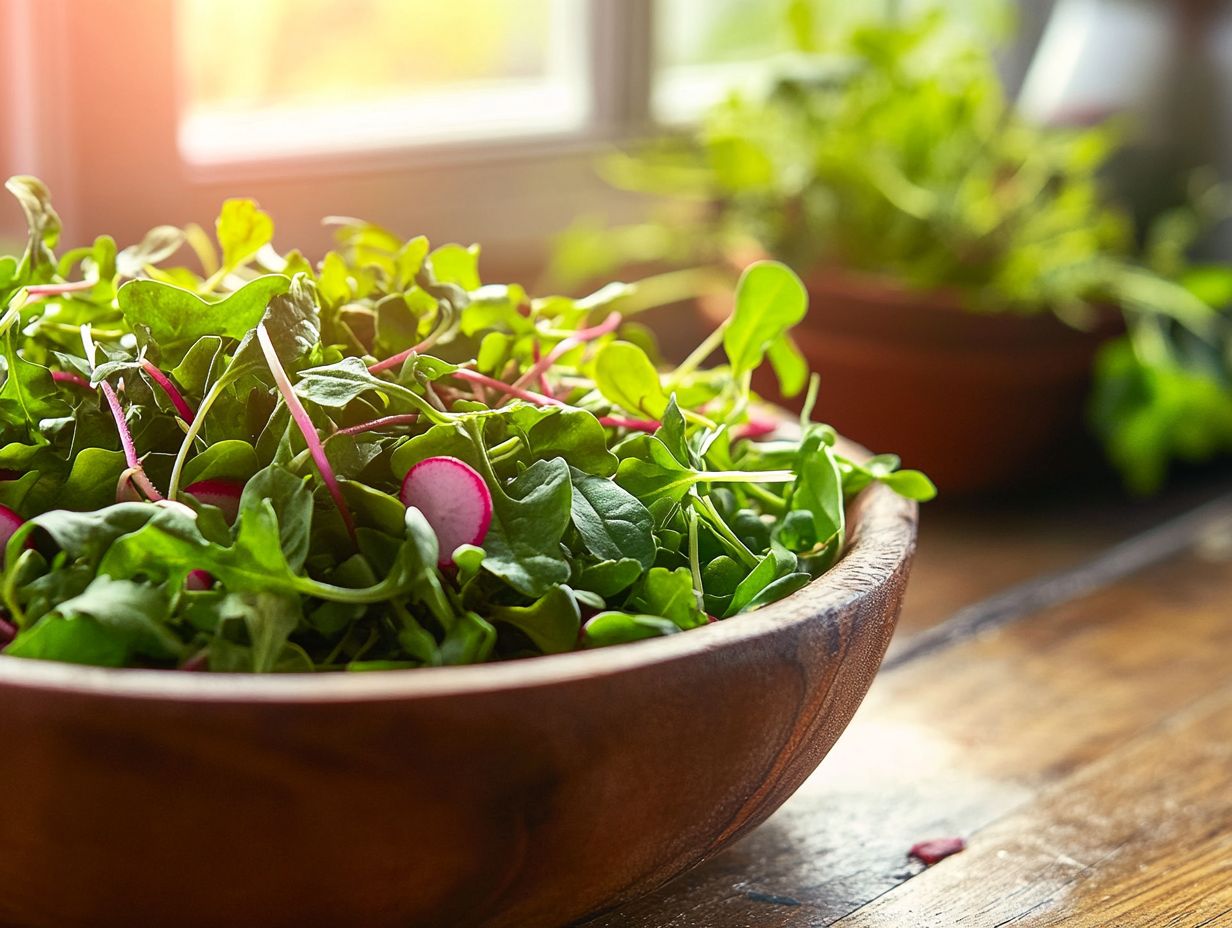
Some of the most nutrient-dense options include broccoli, kale, and pea shoots. These greens are high in vitamins A, C, and K, as well as minerals like iron, calcium, and potassium.
What are the health benefits of incorporating microgreens into my diet?
Microgreens are rich in antioxidants, which help protect the body from damage caused by free radicals. They also contain fiber, which aids in digestion and can promote weight loss. These greens are also low in calories and can help reduce the risk of chronic diseases.
How can I use microgreens to make my meals healthier?
Microgreens can be added to salads, sandwiches, smoothies, and even used as a garnish for main dishes. They are a simple and delicious way to boost your health!
Can anyone grow microgreens at home for a healthier lifestyle?
Yes, anyone can grow microgreens at home, as they require minimal space and equipment. You can purchase microgreen seeds or grow them from vegetable scraps like carrot tops and beet greens. They are a great option for those who want to have fresh, nutrient-rich greens readily available at home.
Are there any potential risks to consuming microgreens?
While microgreens are generally safe to consume, it is essential to practice proper food hygiene when growing and handling them. Always wash the greens thoroughly before consuming, and be cautious of any allergies or sensitivities to specific types of microgreens. If in doubt, consult with a medical professional before adding them to your diet.
Why wait? Start your microgreens journey today and enjoy the taste and health benefits right at home!

